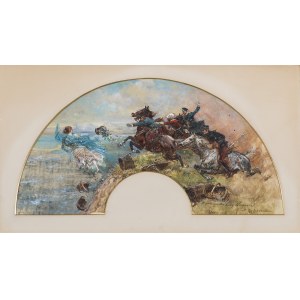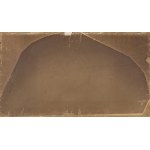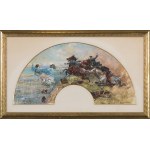watercolor, gouache, swan-skin, 24 x 70.4 cm (in a fan-shaped passe-partout)
Signed p. d.: A mademoiselle Lilly Wanamaker | Albert de Kossak | Berlin 1896
The watercolor bears a dedication to the youngest daughter of John Wanamaker, American merchant and founder of Philadelphia's first department store. Wanamaker opened his first store in 1861 adjacent to the home of President George Washington. He was an avid collector of art and antiques. He made several donations to the University of Pennsylvania's Museum of Archaeology and Anthropology, among them a collection of bronze reproductions of artifacts discovered in the ruins of Pompeii and Herculaneum.
Initially, the fans served a utilitarian function. They were part of a woman's closet complementing exquisite dresses. They were worn to theaters, balls or during social gatherings. The precision of the painting was important, and their decoration had to be neutral and appropriate to the situation. They were painted with idealized genre or historical scenes. It was not until the mid-1880s that artists allowed themselves to decorate fans more freely, sometimes even impasto. Fashionable plate and pleated fans, painted by well-known artist-painters, in the second half of the 19th century began to lose their utilitarian role in favor of a purely aesthetic, commemorative and collector's function: instead of serving as a fashion accessory, they adorned living room walls or were placed in serviettes, constituting the pride of their owners, just like other works of art (quoted in J. Różańska, Polski wachlarz malowany 1850-1914, Warsaw 2006, p. 7). Such painted fans were often not pleated or stretched on a frame; framed in passe-partout and frames, they served as paintings from the beginning.
Wojciech Kossak (Paris 1856 - Krakow 1942 ) - widely known painter, seen primarily as a great battle artist. The son and pupil of Juliusz Kossak, he was educated at the Cracow School of Fine Arts, the Munich Academy and in Paris. In 1895-1902 he stayed mainly in Berlin, working for Kaiser Wilhelm II. He traveled extensively, including to Spain and Egypt, where he made sketches for intended panoramas. In later years, he traveled to the United States several times doing portrait commissions. In 1913 he was appointed professor at the Warsaw School of Fine Arts. During the years of World War I, he served in the military. He was co-author of panoramas: "Raclawice" (1893-1894), "Berezina" (1895-1896), "Battle of the Pyramids" (1901) and sketches for the unrealized "Somosierra" (1900). With temperament and freedom, he created extensively painted dynamic battle scenes, historical scenes, genre scenes and numerous portraits. He was fond of painting horses. His paintings, glorifying the Polish military and the heroism of soldiers, both ancient and contemporary to the artist, appealed to the patriotic feelings of the public and enjoyed great popularity.













